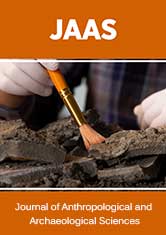
Lupine Publishers Group
Lupine Publishers
Menu
ISSN: 2690-5752
Opinion Article(ISSN: 2690-5752) 
The Hidden Meaning of the Sword in the Stone Volume 9 - Issue 1
Felice Vinci* and Arduino Maiuri*
- Sapienza University of Rome, Italy
Received:November 14, 2023; Published: November 24, 2023
Corresponding author:Arduino Maiuri, Sapienza University of Rome, Italy
DOI: 10.32474/JAAS.2023.09.000301
Introduction
The first mention of the famous Sword in the Stone of the Arthurian cycle is found in Robert de Boron’s Merlin, a medieval French poem dating back to the end of the 12th century and the beginning of the 13th, according to which Arthur obtained the British throne by pulling a sword (which would later be called Excalibur) from an anvil sitting atop a stone [1]. This singular story can make us ask whether it hides a metaphor or a symbolic meaning. To try to clarify the question, first of all we observe that the sword pulled by Arthur corresponds to the sword that Galgano Guidotti is said to have thrust into a stone in the year 1180, which is still visible in the Montesiepi Chapel, near the Cistercian Abbey of San Galgano [2], located in the Metalliferous Hills (30 km from Siena). Recalling that the Arthurian legends were also born in a Cistercian environment, we note on the one hand that the name of Galgano itself can be compared to that of Gawain – Arthur’s nephew who in Chrétien de Troyes’ (Perceval) is the holder of the sword Excalibur – and, on the other hand, that in the Abbey of San Galgano during the Middle Ages, a foundry was active for the production and processing of iron extracted from the pyrite which abounds in the Metalliferous Hills. Also giving further food for thought is the name of the Merse river, which flows near the Abbey and recalls Mars, the god of war on whose relationship with the sword Georges Dumézil made a specific study. Moreover, the Merse has a suggestive homonym in the Mersey River in north-western England [3]. At this point it is reasonable to hypothesize that the expression «pulling the Sword from the Stone» is a metaphor, referring to the skill to make a sword, “pulling” it from the stone containing the iron ore. In short, the legend of the Sword in the Stone could be deciphered in a metallurgical key, that is, as a metaphor of the activities of ancient blacksmiths, who made swords by producing and working iron starting from the ore contained in certain rocks (or maybe it was even a sort of “trademark” of theirs or of their very activity as metalworkers?). Furthermore, the name itself of the sword, ( ) [4], recalls the Chalybes, famous blacksmiths of antiquity [5]. Here in the following we will see if this interpretation of the legend finds further confirmation. We first observe that with a similar key, in a recent study [6], the solution to Samson’s age-old riddle was proposed: «Out of the eater came something to eat, and out of the strong came something sweet» [7], which a swarm of bees and honey in the carcass of a roaring lion that the biblical hero had torn apart in Timnah, and which has remained unsolved for millennia. It is therefore appropriate to carefully analyze this strange riddle: its apparent bizarreness immediately gives rise to the suspicion that it might actually be a well-thought-out metaphor, behind which in fact a very specific meaning seems to hide. Revealing in this regard is the fact that in the Timna Valley, in southern Israel, in the last century the traces of an important copper mining activity were discovered, which continued uninterruptedly from the Neolithic to the Middle Ages, and have been brought to light the remains of an Egyptian shrine dedicated to Hathor, the goddess of mining, built at the end of the 14th century BC for the Egyptian miners, whose great importance is attested by thousands of hieroglyphs, sculptures and jewels [8]. From here the idea was born that Samson’s riddle can be interpreted in a metallurgical key, as an ingenious metaphor of the smelting furnace: in fact it seems to “devour” ore with fire – producing a dull noise that recalls both the roar of the lion and the buzz of bees around the hive – but then copper flows out, which has a colour similar to that of wild honey. The Timna shrine, therefore, indicates a dimension conceptually similar to that of the San Galgano Abbey, where, as we have seen, metallurgical activities took place in a religious context. Furthermore, that singular relationship between metallurgy and bees can be also found in the Greek myth of Zeus’s birth, attended by some gigantic bees [9] together with the Curetes, who were linked to the mysteries of metallurgy. But it is even found in the Finnish epic (Kalevala), in a passage where the myth of the origin of iron is told [10], according to which the legendary blacksmith Ilmarinen used the honey of the bee Mehiläinen to temper the metal.
Not only that: in the Vedic world, in the sacrificial area, in addition to the two main fires (one quadrangular, “male”, and the other circular, “female”) there was a third, the “hungry fire”, considered a “devourer” which had guard functions and which Georges Dumézil identifies with the god Vulcan [11] of the Roman world. Indeed, the fire of the smelting furnaces, necessary to build the weapons that protect the community, falls precisely into this case, which is well suited to that metaphor of the “devourer” found in Samson’s riddle, which in turn is comparable to the legend of the Sword in the Stone.
In the Greek world, a similar tale is that of Heracles who kills the Nemean lion with his bare hands, just like Samson. But this “lion” also appears very strange, because its fur is completely invulnerable to any type of weapon; however, in the end Heracles manages to strangle it [12]. On the other hand, Hercules, the Roman equivalent of Heracles, in turn kills with his bare hands the monstrous giant Cacus, who had stolen a herd of oxen from him: Hercules chases him, reaches him in the cave of the Aventine Hill where Cacus lived, and finally kills him by suffocating him. But Cacus, shortly before being grabbed by Hercules, began to emit smoke and flames, to the point that «his great cave was filled with a black cloud» [13]. Here the comparison is obvious with the “metallurgical lion” killed by Samson, from which the “honey” then comes out, an extraordinary metaphor of the copper that flows from the smelting furnace, as confirmed by the «flames that Cacus emitted in the darkness» [14], the last memory, perhaps, of a primordial forge on the slopes of the Aventine. Still regarding Hercules, a singular variant of the motif of the sword being stuck in the stone and then extracted is found in a legend reported by Servius: «One time Hercules, returning from Spain, came to these people (the Ciminians). When he was called upon by various individuals to display his prowess, it is said that he stuck in the ground an iron bar with which he trained. After the bar had been embedded and was unable to be moved by anybody, they asked him to remove it; he did so, and from that place a great rush of water followed which created the Lake Ciminius» [15]. Indeed, this lake of volcanic origin [16] gave its name to the ciminites [17], rocks containing iron minerals: we can deduce an ancient metallurgical activity in that area, similar to what we found in the Metalliferous Hills, located a little further north. At this point it seems plausible that also the Japanese myth according to which the god-hero Susanoo, a character that was compared to Samson [18], kills and dismembers a fearsome dragon, in whose tail he finds the great sword called (Kusanagi) which is considered one of the three Imperial Insignias of Japan), can be interpreted in a metallurgical key [19].
Conclusion
We have ascertained that the act of pulling the Sword from the Stone can be interpreted as a metaphor for metallurgical activities, with specific reference to the skill to make a sword starting from a stone containing iron ore. This interpretation finds various confirmations, as we have verified here by analyzing several examples taken from cultures even very distant in space and time, such as the very strange lion in whose carcass Samson finds honey and bees, the Nemean lion slew by Heracles, the grotesque firebreathing Cacus suffocated by Hercules, the bees attending the birth of Zeus, the “devouring” fire in the rituals of the Vedic world, the Finnish blacksmith Ilmarinen tempering iron with honey, the Japanese hero Susanoo who finds a sword in the tail of a monstrous drake; not to mention the sword pulled by Volsung from a tree and the one dug up by Theseus. Il is also likely that in the future further studies and insights will extend these correlations to other mythologies as well. Furthermore, the great distances that separate these cultures seems to attest to the antiquity of these conceptions and could substantiate the hypothesis of a prehistoric global civilization, spreading its ships throughout the planet, of which Plato might have left the last memory by passing down the myth of Atlantis. Whatever the case, this interpretation of the legend of the Sword in the Stone underlines the importance of metalworking in the ancient world.
References
- This text is available on N. Bryant (transl.), Merlin and the Grail: Joseph of Arimathea, Merlin, Perceval. The Trilogy of Prose Romances Attributed to Robert de Boron, D.S. Brewer, Cambridge, 2001.
- V Albergo (2011) San Galgano: eremo e abbazia, Tellini, Pistoia, 1982, which is integrable with A. Conti, San Galgano: il santo, l’eremo e l’abbazia. Storia e storie intorno alla spada nella roccia, Aska, Montevarchi.
- W T h Palmer (1944) The River Mersey, Robert Hale Ltd.
- The Latinized version Caliburnus is attested in Historia Regum Britanniae by Geoffrey di Monmouth: cf. e.g. Th. Bane, Encyclopedia of Mythological Objects, McFarland, Jefferson (NC), 2020, s.v. Excalibur, p. 63.
- F Muller (2016) Une étymologie grecque d’«excalibur», «Bulletin de l’Association Guillaume Budé» 2(1): 79-95.
- M B Bittarello (2016) The Chalybes as Mythical Blacksmiths and the Introduction of Iron, «Mouseion» 13(1): 497-534.
- F Vinci, A Maiuri (2023) A Hypothesis of Solution of Samson’s Riddle, «Athens Journal of Mediterranean Studies» 9(1): 271-278. Jdg. 14:14.
- Here the “Central Timna Valley Project” was fundamental, directed by E. Ben-Yosef of Tel Aviv University after the death of B. Rothenberg, who was responsible for the discovery of the temple of Hathor in the second half of the 20th century. Cf. B. Rothenberg, Were These King Solomon’s Mines? Excavations in the Timna Valley, Stein & Day, New York, 1972; Id., Researches in the Arabah, 1959-1984: The Egyptian Mining Temple at Timna, Thames & Hudson, London, 1988; J.M. Tebes, A Land Whose Stones Are Iron, and out of Whose Hills You Can Dig Copper. The Exploitation and Circulation of Copper in the Iron Age Negev and Edom, «DavarLogos», 6, 2007, pp. 69-91; E. Ben-Yosef (ed.), Mining for Ancient Copper: Essays in Memory of Professor Beno Rothenberg, Institute of Archaeology of Tel Aviv University, Tel Aviv, 2018.
- This is a variant reported by K. Kerényi, Miti e misteri, Einaudi, Torino, 1950, pp. 413-423.
- Kalevala, rune IX. Incidentally, one should also note that here the iron comes from a black, a white and a red milk, which not by chance correspond to the three traditional colours of alchemy (representing the three stages of transformation of matter, nigredo, rubedo and albedo), which in turn could be related to the various phases of incandescence, when the temperature gradually rises to “red heat” and then to “white heat”.
- G Dumézil, La religione romana arcaica, Rizzoli, Milano, 1977, p. 284.
- Ps Apoll., Bibl. 2, 74-76.
- Fumus agit nebulaque ingens specus aestuat atra (Verg., Aen. 8, 258).
- Hic Cacum in tenebris incendia vana moventem (ib., v. 259).
- Aliquando Hercules cum de Hispania rediret ad hos populos venit. Qui cum a singulis provocaretur and ostendendam virtutem, defixisse dicitur vectem ferreum, quo exercebatur. Qui cum terrae esset adfixus et a nullo potuisset auferri, eum rogatus sustulit, unde inmensa vis aquae secuta est, quae Ciminum lacum fecit (Serv., ad Aen. 7, 697).
- It is called Lago di Vico now, 60 km from Rome.
- R W Le Maitre (2002) Igneous Rocks. A Classification and Glossary of Terms, Cambridge University Press, Cambridge p. 69.
- G de Santillana, H von Dechend (2003) Il Mulino di Amleto. Saggio sul mito e sulla struttura del tempo, Adelphi, Milano p. 205.
- The hero-sword-dragon triad is also attested in Germanic mythology (the hero Sigurd kills the dragon Fafnir with the sword Gram that his father Volsung had pulled from the tree where it had been thrust by the god Odin), as well as in the Greek one (Theseus discovers his royal origins by digging up the sword that had been buried by his father under a huge rock, and in a later adventure kills the monstrous Minotaur).

Top Editors
-

Mark E Smith
Bio chemistry
University of Texas Medical Branch, USA -

Lawrence A Presley
Department of Criminal Justice
Liberty University, USA -

Thomas W Miller
Department of Psychiatry
University of Kentucky, USA -

Gjumrakch Aliev
Department of Medicine
Gally International Biomedical Research & Consulting LLC, USA -

Christopher Bryant
Department of Urbanisation and Agricultural
Montreal university, USA -

Robert William Frare
Oral & Maxillofacial Pathology
New York University, USA -

Rudolph Modesto Navari
Gastroenterology and Hepatology
University of Alabama, UK -

Andrew Hague
Department of Medicine
Universities of Bradford, UK -

George Gregory Buttigieg
Maltese College of Obstetrics and Gynaecology, Europe -

Chen-Hsiung Yeh
Oncology
Circulogene Theranostics, England -
.png)
Emilio Bucio-Carrillo
Radiation Chemistry
National University of Mexico, USA -
.jpg)
Casey J Grenier
Analytical Chemistry
Wentworth Institute of Technology, USA -
Hany Atalah
Minimally Invasive Surgery
Mercer University school of Medicine, USA -

Abu-Hussein Muhamad
Pediatric Dentistry
University of Athens , Greece

The annual scholar awards from Lupine Publishers honor a selected number Read More...




